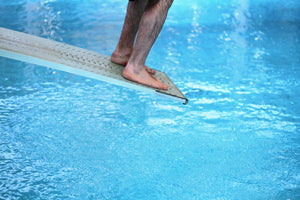How to Ride the Diving Board
June 04, 2024

 You’ve likely heard your coach say, “Ride the Board!” What exactly does this phrase mean? Riding the board is a technique that connects the rhythm of your body (in the forward and backward approach), to the timing of the springboard’s natural flex. In essence: When the board goes down; you go down. When the board goes up; you go up.
You’ve likely heard your coach say, “Ride the Board!” What exactly does this phrase mean? Riding the board is a technique that connects the rhythm of your body (in the forward and backward approach), to the timing of the springboard’s natural flex. In essence: When the board goes down; you go down. When the board goes up; you go up.
Springboard diving boards are designed to bend, arc, and create spring. When you are able to coordinate the rhythm of your body to the bend of the diving board, you can ensure a more successful dive. However, learning to ride the board is by no means an easy task. It takes years to master this skill!
Below are three drills that will help you learn this important technique so you can fly high on your dives.
Bounce the Board
In order to learn to ride the board, you have to bounce the board. This takes time and practice. Try to include these drills into your daily routine:
When the timing is off between the board and body, it is called stomping the board. When this occurs, the board is coming up as the diver is coming down. There is a loud “stomping” sound. This action kills the spring, and the dive loses height because of it.
Bounce without Air
Stand at the end of the diving board with your body facing the water. Bend your legs and manipulate the diving board up and down. Do this without having your feet ever leave the board. Feel the timing, flexing, and arc the board creates. You should feel the sensation from your feet, and up through your knees.
Bounce with Air
Stand at the end of the diving board with your body facing the water. Bounce three times, with your feet leaving the diving board. Work to maintain the rhythm of the board: When the board bends down; your body is pressing it down. When the board rises; your body is rising at the same time. If you are doing this correctly, you should be able to bounce three continuous jumps without exiting the diving board.
Adjust the Fulcrum
The fulcrum is the adjustable wheel that sits under the diving board. The fulcrum setting corresponds to a set of numbers that are listed on the diving board. The numbers range from one to nine. If the fulcrum is set at one, the board will bend very little (or not at all). When it is set to nine, the board will bend as much as possible.
Just because the board is at its maximum arc potential, does not mean you will get the maximum height for your particular dive. The timing will be off if the board is too springy for your skill level, body weight, or size. In this case, you will stomp the board and kill your spring.
Because of this, it’s important to play around with the fulcrum settings to determine what works best for you. Here is a general guideline for forward and backward takeoffs:
- Forward takeoffs: Try the fulcrum in the middle of the board; around five. Take a few bounces on the end of the board. If the timing is off — the board is coming up when you are going down — move the fulcrum backwards a bit. To level six, for example. Keep adjusting this until you get the best timing for your body.
- Backward takeoffs: For back takeoffs, the fulcrum is generally set tighter than for forward approaches. The reason for this is fairly obvious: A standing back approach will not generate as much spring as a walking forward approach. Try the fulcrum at a setting that is two numbers lower than your forward takeoff. Practice a standing back press, and determine if this setting is correct for you.
As your body grows or your skill level increases, you will need to revisit the fulcrum setting. Riding the board corresponds to both your body size and skill level. As either one changes, it is important to adjust your fulcrum setting accordingly.
Practice Patience
The biggest mistake divers make when trying to ride the board is rushing. Divers are so eager to perform the dive that often they don’t wait for the timing of the board.
Riding the board takes patience. Not only does it take patience to learn this technique, it takes patience to master it. You must let the board complete its arc before you perform your dive.
Start every practice with a set of five forward and five backward approaches. Here are a few tips to concentrate on while working on this skill:
- Forward approach: In the jump of your hurdle, concentrate on keeping your arms above your head until your toes make contact with the board. Only lower your arms and begin your arm circle after your feet have landed on the diving board.
- Back press: Rock the board before you raise your arms above your head. When your arms rise, the board should also rise. When your arms swing down, your legs should be pressing the board down. This timing will ensure the maximum height potential for your dive.
Timing is Everything
Riding the board sounds easy; but it is surprisingly difficult to accomplish. Timing is the most difficult aspect. In order to get the maximum height on your dive, you must wait for the board to complete its arc.
Mastering this timing takes both skill and patience. Work diligently, and eventually you will connect with the board and soar through the air!



